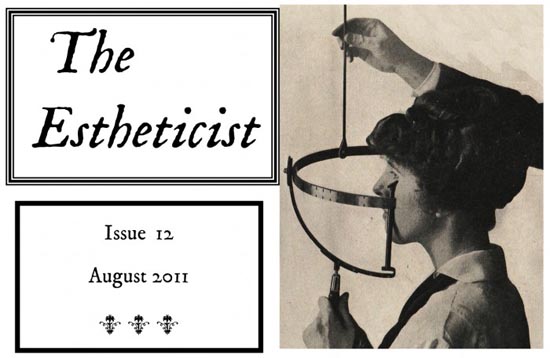Lafayette Anticipation associate curator Anna Colin talks to artist Tyler Coburn about Ergonomic Futures, a speculative project engaged with art, design, science, anthropology and writing. In this interview, Coburn discusses the research, production process and network of collaborators of a multilayered project ultimately concerned with the futures of humankind. Anna Colin: When one comes across your museum seats Ergonomic Futures (2016—) in contemporary art exhibitions—and soon in natural history, fine art, and anthropology museums—they look… [read more »]
The Estheticist (a recompilation from present and past issues)

The Estheticist is a free ongoing service of art consultation around practical, philosophical and ethical issues around the visual arts profession. To ask a question, email estheticist [ at ] aol.com. Participants accept that their questions may be used for a printed publication that will serve as a professional development tool for emerging professionals in the arts. Your question will be confidentially and the question will appear as anonymous unless you specify otherwise.
To see previous issues, click here.
This is a recompilation of answered questions from diferent issues of The Estheticist
For more visit The Estheticist
Dear Estheticist,
Is not making art art?
Fluxus artist, France
Dear Fluxus artist,
This is more of a logical than an aesthetic paradox, and it all depends on whether you are stating “ I am not making art”. If you say that you are not something, (think of Nixon’s infamous “I am not a crook” statement) you (intentionally or not) are still defining yourself against it, and invite the possibility for someone to argue the opposite. This dynamic is the central engine of art. Non-art is an extension of art as it is a negative territory determined by the existence of art, or rather, it is “art-at-large” (see The Neologist section). In his Negative Dialectics, Adorno argues that we achieve meaning on objects through negations, not through affirmations. What one needs to do in order to effectively abandon the possibility that something may not ever be art is to escape the declarative territory, where non art cannot even be named, where it remains invisible. The moment we find it, we have already taken a step to claim it as art.
Sincerely,
The Estheticist.
Dear Estheticist,
Can curators be artists?
Sincerely,
Obviously, a Curator.
Dear Obviously a Curator,
The curatorial practice is creative in its own right, but even if the curatorship of an exhibition is so brilliant as to have the resonance of an artwork, it should not aspire to be seen as one. Artworks are entities that call attention onto themselves. When curatorial projects behave that way, they usually do so at the expense of the artworks included. At some point in the 90s, around when Nicolas Bourriaud wrote Post-production, we thought that the era of the original art was over and what would replace it was only the ability to combine things, to paste together, the era of the DJ. And in truth, this new activity has become an art in its own terms, curatorial practice included. But it has not replaced artmaking altogether. So when one curator tries to make his or her art using other people’s artworks, that usually doesn’t come off well. The problem is not on whether the curatorial practice can be considered a creative endeavor, but rather that curators who really want to be artists end up being bad artists and bad curators.
Sincerely,
The Estheticist
Dear Estheticist,
What is the point of a poor derivation/ version of “Untitled Film Stills”?
Brooklyn Potter
Dear Brooklyn Potter,
Your question seems less a question than the downright statement that a poor, derivative work (in this case, of Cindy Sherman’s “untitled film stills”) is pointless. In any case, let’s see if that is actually true by unpacking your question/statement in two parts: 1. Is derivative work pointless? and 2. Is a poorly made work pointless?
If by “pointless” you mean that it doesn’t contribute significantly to advancing the discussion or dialogue in art, it would be a hard thing to prove. Sherrie Levine’s work is all built on derivation, but that is indeed its point. But without going to such extreme: is art done under the influence of a particular “school” pointless? Let’s say it is, but then I am afraid that encyclopedic museums would have to discard most of their works. Part of the problem of saying that a derivative work is pointless is that it is almost impossible to determine when a work stops being indebted to past artworks and becomes its own original “self”; in fact the consensus is that it is practically impossible to make an artwork that does not derive some of its references to previous art. In fact, one can argue that a work can be both derivative and innovative: think of Picasso in how he would “steal” from other artists and yet produce his own original works. Innovation can occur by using existing structures.
Furthermore, it is important to remember that the notion of “derivativity” as applied to art is a modern creation: not all historical periods, or cultures, have always praised originality as the highest aspiration for a work. And even today, if you read Marjorie Perloff’s “Unoriginal Genius”, she makes a strong case for contemporary writers who intentionally, and successfully, question the very notion of originality as inextricable to meaningful art.
As to whether there is a point in a poorly made work, that depends on the eye of the beholder. If you consult the Museum of Bad Art, you will see that the curators have found great value in some of the most aesthetically offensive works ever made, effectively turning them around to make us enjoy them as masterpieces of naiveté.
Sincerely,
The Estheticist
Dear Estheticist,
I am a final year fine art student/ emerging artist interested in the art world market. I am torn between passion (traditional painting) and conceptual art – which I also enjoy. Is it “selling out” to go down the commercial art route with painting? Is this wrong? Is conceptual art right?
E.M.
Dear E.M.,
You are making lots of innacurate assumptions. Conceptualism doesn’t lack passion; making traditional painting doesn’t guarantee commercial success; and there is no “right” medium. If your desire is just to make money, you are indeed selling out, regardless of what work you make.
Your situation is not unusual. Many emerging artists who are graduating have to negotiate a number of apparently opposing aesthetic stances, being seduced by all of them at once. “Traditional” painting —and by that I understand painting rooted in XIXth century aesthetics and techniques— may feel like a safer choice, as it is grounded in those familiar terrains, but the truth is that it is equally difficult to produce innovative work in any medium. You likely are not ready to make a choice yet: you need to resolve your assumptions about conceptualism vs. painting first by continue to experiment, make work and look at other artists who have addressed both painting and conceptualism. You can only know what side of the spectrum you are in by making work, and only by making work that you truly believe in you can hope to be satisfied. Commercial success may follow.
Sincerely,
The Estheticist.
Dear Estheticist,
My work is about challenging the system of art, but how can I engage the art world if to engage with it is essentially against my rules? Either I stay isolated forever or lose the integrity of my practice.
Sincerely,
Outsider, California
Dear Outsider,
My suspicion is that you never really wanted to be outside in the first place. If you are so concerned by the acknowledgement of the art world for the kind of work that you do, most likely you regarded your supposed rebellion against art as some kind of vacation from the system, but always with the hopes that they system will come back to embrace you. It may be better for you to come to terms to that fact, and once having established that, think about how you can still challenge the system by still being engaged within it. If, on the contrary, you find that your philosophical stance really takes you outside of it, you will not miss it much.
Sincerely,
The Estheticist
Dear Estheticist,
I make autobiographical work but my emotions sometimes get on the way. People tell me that the work is too sentimental and even corny at times, but I feel that if I don’t insert my feelings and my personal life in the work, the work is dead. What to do?
Romantic
Dear Romantic,
Self-portraiture, or autobiographical work is a perennial subject for art, and there is a lot of successful autobiographical, even confessional work out there. At the same time it is an extremely difficult kind of work to do — for every interesting autobiographical work there are hundreds, if not thousands, of over-indulgent, uncritical and naïve works by mostly amateur artists who think they are more interesting to the world than they actually are. The temptation to present yourself in a better light, to make your life a great epic, is too great and requires great maturity and detachment to see oneself coldly. This is why to give free range to your emotions when you are making a work about yourself may end up turning people off. You should consider some “detachment” strategies, like thinking of other subjects as proxies of yourself, which may allow you to gain some distance and perhaps even to discover more things about yourself. Like Flaubert, who claimed ‘Madame Bovary, c’est moi’, practically every artwork we do is a self-portrait.
Sincerely,
The Estheticist.









































































